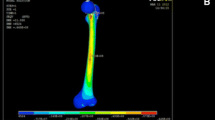Summary
By using X-ray films of 390 adult femurs and 15 cadaveric femurs of Japanese origin, and by measuring successive cross-sections the authors have made morphological and statistical analyses of the shape of the femoral medullary canal. These studies suggest new dimensions for the diameter of the reamer and the amount of contact area between nail and inner cortex. Furthermore it was found that the physiological antecurvature of the femur on the lateral view does not correspond with the prebending of the AO-nail. The authors made some mechanical experiments on four types of nails which are widely used today.
As a consequence of these studies, the authors developed a new elastic nail for trial (Okayama-nail). This new type of nail greatly increases the area of contact with the inner femoral cortex. Obviously this nail satisfies better all of Kuentscher's originally mentioned requirements an intramedullary nail.
Zusammenfassung
An einer röntgenanatomischen und morphologischen Vorstudie von insgesamt 390 Femora japanischer Individuen wird die Markraumarchitektur besonders im Bereich der physiologischen Enge, dem sogenannten Markraumisthmus, untersucht. Diesem Bezirk kommt besondere Bedeutung bei der Fixation eines intramedullären Kraftträgers zu, da nur hier ein formschlussüger Kontakt des Implantates mit der Markhöhle erwartet werden kann. Als wichtigstes Ergebnis finden die Untersucher, daß der Durchmesser des Markraumisthmus' auf dem ap-Bild um 2 mm kleiner ist als auf dem seitlichen Röntgen bild, weshalb beim Aufbohren der Markhöhle 2 mm Zugabe zum ap-Durchmesser notwendig ist, um einen kreisförmigen Querschnitt zu erzielen. Weiterhin konnte nachgewiesen werden, daß die Vorbiegung des AO-Marknagels nicht der zumindest in Japan zu erwartenden Antekurvation des Femurs entspricht. Verschiedene Versuche an 4 im Handel befindlichen Marknagelmodellen geben Aufschluß über deren elastische Eigenschaften.
Um die Forderung nach möglichst großflächigem Kraftschluß zwischen Marknagel und Markraum zu erfüllen, wird ein neuer Nagel (Okayama-Nagel) vorgestellt, der verbesserte querelastische Eigenschaften aufweist and selbst noch fiber den unmittelbar zylindrisch aufgebohrten Markraumbereich hinaus in Kontakt mit der Knochenröhre tritt.
Similar content being viewed by others
Literatur
Böhler, J.: Results in Medullary Nailing of Ninetyfive Fresh Fractures of the Femur. J. Bone Jt. Surg. 31-A, 670–678 (1951)
Fukushima, M.: Technik der Frakturtherapie. J. Jap. Orth. Ass. 47, 215–231 (1973)
Kuntscher, G.: The Kuntscher Method of Intramedullary Fixation. J. Bone Jt. Surg. 40-A, 17–26 (1958)
Kuntscher, G.: Praxis der Marknagelung. Stuttgart: F. K. Schattauer 1962
Kusaka, K., Ishikawa, E.: Osteosynthesematerial. Bull. Jap. Metall. 1, 736–742 (1962)
Lottes, J. O., Key, J. A.: Complications and Errors in Technic in Medullary Nailing for Fractures of the Femur. Clin. Orthop. 2, 38–49 (1953)
Mikulicz, J.: Über individuelle Formdifferenzen am Femur und an der Tibia des Menschen. Mit Berücksichtigung der Statik des Kniegelenkes. Arch. Anat. Entwicklungsgesch. 351–404 (1878)
Willer, M. E.: Manual der Osteosynthese (AO-Technik). Berlin-Heidelberg-New York: Springer 1969
Onoue, Y.: Entwicklung des gebogenen Marknagels fur das Femur. J. Jap. Orth. Ass. 51, 315–329 (1977)
Sofield, H. A.: Anatomy of Medullary Canals. Amer. Acad. Orthop. Surg. Lect. 8, 8–9 (1951)
Stevens, A. E., Turney, J. P.: Intramedullary Nailing for Recent Femoral Shaft Fractures. Brit. Med. J. 1, 208–211 (1957)
Stuck, W. G., Thompson, M. S.: Complication of Intramedullary Fixation of the Femur. A.M.A. Arch. Surg. 63, 675–686 (1951)
Sunami, Y.: Die mechanische Untersuchung des Osteosynthesematerials für Frakturen. J. Jap. Orthop. Ass. 45, 846–848 (1971)
Sunami, Y., Ishikawa, E., Nemoto, G.: Über die hochgradig harte und bearbeitbare neue Legierung COP. Z. med. Maschinol. 41, 471–474 (1971)
Wada, K.: Röntgenanatomische Untersuchungen an Femur und Tibia japanischer Erwachsener. J. Jap. Orthop. Ass. 3, 18–54, 187–235 (1964)
Author information
Authors and Affiliations
Rights and permissions
About this article
Cite this article
Sadakane, T., Nagano, K., Onoue, Y. et al. Anatomische und biomechanische untersuchungen zur femurmarknagelung. Arch. Orth. Traum. Surg. 91, 31–37 (1978). https://doi.org/10.1007/BF00383639
Received:
Issue Date:
DOI: https://doi.org/10.1007/BF00383639




